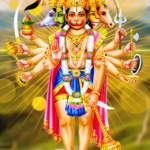The Kishkindha Kandam is the fourth book of the Ramayana, one of the two great Indian epics, composed by the sage Valmiki. This section of the Ramayana is renowned for its deep themes of loyalty, friendship, and courage, as well as its depiction of the adventures that mark Lord Rama’s quest to rescue his beloved wife, Sita. The term “Kishkindha” refers to the ancient kingdom of the Vanaras, a race of monkey-like beings led by the mighty King Sugriva and his valiant chief, Hanuman.
Overview of the Kishkindha Kandam
In the Kishkindha Kandam, Rama and his brother Lakshmana enter the realm of Kishkindha, seeking allies to help in their quest. This section chronicles their encounters with Sugriva and Hanuman, the battle with Vali, the ruler of Kishkindha, and the events that lead to an alliance between Sugriva and Rama. Through this friendship, Rama gains the support of an army that will later aid in the epic battle against the demon king Ravana.
The Significance of Kishkindha
Kishkindha, often depicted as a dense, wild, and mountainous forest kingdom, is an ideal setting for the heroic narratives of the Vanaras. This mystical land serves as both a hiding place and a battleground for the Vanara kings, Sugriva and Vali, who are embroiled in a fierce sibling rivalry. Rama’s journey through this kingdom is central to his path of dharma, or righteousness, and is where he acquires crucial allies for his mission.
Key Themes in Kishkindha Kandam
- The Bonds of Friendship and Loyalty
The friendship between Rama and Sugriva exemplifies loyalty and mutual respect. In his alliance with Sugriva, Rama agrees to assist him in reclaiming his throne from Vali. In return, Sugriva vows to help Rama locate Sita and gather an army to confront Ravana. This bond highlights the importance of alliances and mutual support in the face of adversity. - Brotherhood and Conflict
The sibling rivalry between Sugriva and Vali is a central plotline. Their estrangement stems from misunderstandings, mistrust, and a series of tragic events. Vali’s sense of betrayal and Sugriva’s longing for justice and reconciliation reflect the complex dynamics of familial relationships and the power struggle within royal families. - Justice and the Concept of Dharma
Dharma, the principle of righteousness and moral duty, plays a crucial role in the Kishkindha Kandam. Rama’s decision to help Sugriva reclaim his throne aligns with his commitment to uphold justice and dharma. However, his act of killing Vali from behind a tree stirs debate about the nature of dharma, emphasizing that moral decisions are often complex and nuanced.
Key Events in Kishkindha Kandam
Rama and Lakshmana’s Meeting with Hanuman
Rama and Lakshmana’s journey through the forest leads them to meet Hanuman, Sugriva’s loyal minister and warrior. Hanuman’s wisdom, strength, and devotion to Rama are immediately evident. This first encounter is marked by respect and admiration, forming the foundation of a profound and enduring friendship.
The Story of Vali and Sugriva
Sugriva narrates his conflict with Vali to Rama, explaining the circumstances that led to their enmity. In their past, Vali had assumed Sugriva betrayed him, resulting in Vali’s prolonged hostility and exile of Sugriva from the kingdom. Rama, moved by Sugriva’s plight, agrees to help him in his struggle against Vali.
Rama’s Battle with Vali
The confrontation between Rama and Vali is a defining moment in the Kishkindha Kandam. With Rama’s support, Sugriva challenges Vali to a duel. During the battle, Rama intervenes, killing Vali with an arrow. Although Vali questions the righteousness of Rama’s actions, Rama justifies his choice by emphasizing the importance of upholding justice and helping an ally in need.
The Alliance with Sugriva and the Search for Sita
With Vali defeated, Sugriva is restored to the throne of Kishkindha. True to his promise, he commands his army to search for Sita. He appoints Hanuman as the leader of the search party, a decision that propels Hanuman’s heroic journey to Lanka and leads to his discovery of Sita.
Characters in Kishkindha Kandam
- Rama – The heroic prince of Ayodhya, whose devotion to dharma is unwavering. His loyalty to his allies and his determination to find Sita underscore his commitment to righteousness.
- Sugriva – The exiled king of Kishkindha, who allies with Rama and fulfills his promise by aiding in the search for Sita. His character represents resilience and the power of alliance.
- Vali – The powerful elder brother of Sugriva, who rules Kishkindha before his death in battle with Rama. His tragic character evokes complex emotions about justice and loyalty.
- Hanuman – Sugriva’s loyal minister and one of the most celebrated figures in Hindu mythology. His unwavering devotion to Rama and his bravery become central to the story as he sets out to find Sita.
Symbolism and Allegory
The Kishkindha Kandam serves as an allegory of inner and outer battles that one must face on the journey of life. Kishkindha symbolizes the wilderness of confusion and strife, and Rama’s interactions here mirror the courage needed to overcome obstacles. The battle with Vali can be seen as a symbol of the inner struggle for virtue and the ethical complexities of upholding justice.
The Legacy of Kishkindha Kandam
The Kishkindha Kandam holds a revered place in the Ramayana and continues to inspire themes of loyalty, heroism, and righteousness. Hanuman’s devotion to Rama and the unwavering bond between Rama and Sugriva resonate deeply with readers and devotees. The ethical dilemmas in this section, especially surrounding the killing of Vali, prompt discussions on dharma, reinforcing that true righteousness often demands both courage and compassion.
Conclusion
Kishkindha Kandam is a tale of courage, friendship, and moral integrity. It showcases the essence of loyalty and the challenges of maintaining dharma amidst complex situations. The narrative offers timeless lessons on the importance of alliances, the strength of friendship, and the nuances of justice. As part of the Ramayana, Kishkindha Kandam continues to inspire, reminding readers of the power of faith, duty, and the unbreakable bonds that uplift humanity.







